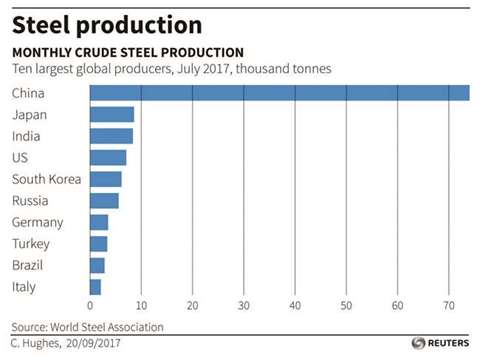Thyssenkrupp Steel and Tata Steel’s plans to merge in Europe could enable them not just to cut costs but also raise prices, customers and shareholders say.
The planned joint venture, announced on last Wednesday, would create Europe’s second-largest steel maker, with a market share of about 13%, according to data from the companies and the World Steel Association.
This would make the group, to be named Thyssenkrupp Tata Steel, a distant second to global leader ArcelorMittal, which has a 26% share.
Although Thyssenkrupp Steel Europe and Tata Steel Europe say their client groups are largely complementary, they have significant overlap in the autos industry, their largest market, company data shows.
Below are some details on pricing and the joint venture’s potential client structure.
European steel prices, even though volatile and under continued pressure from cheap Chinese imports, have recently stabilised, providing the day-to-day business.
Currently at €530 per tonne, European steel prices are still down by about a third compared with their pre-financial crisis peak, but have risen by nearly two-thirds since their most recent record at the end of 2015.
They are down about 3% in the year-to-date and investors reckon that the further consolidation could support a recovery.
“An oligopoly has a different power to set prices than a more fragmented market,” said Thomas Vorlaufer, fund manager at Deka Investment, Thyssenkrupp’s 10th-largest shareholder. “As a result there can be an impact on prices.”
Higher prices would mostly hit the automotive industry, which would account for about 40% of sales of the combined entity.
German luxury car maker BMW, a customer of Thyssenkrupp Steel Europe, Tata Steel Europe and ArcelorMittal, fears that the merger could change things for the worse.
“We have a critical view and are concerned over whether the steel market will still function efficiently following a merger,” a spokesman for the company said.
A spokesman for Peugeot, which gets deliveries from Tata Steel Europe, said he did not expect any impact on prices.
Volkswagen and Daimler, also clients of Thyssenkrupp Steel Europe, declined to comment.
“Our businesses and those of Tata complement each other well,” Thyssenkrupp said on Wednesday, adding that while it was stronger in the automotive sector, Tata Steel Europe had a bigger exposure to industrial customers.
However, automotive is big business for both groups. Thyssenkrupp Steel Europe makes 46% of its sales, or €3.51bn ($4.21bn), from clients in the automotive industry.
At Tata Steel Europe, whose customers also include Tata Motors’ Jaguar Land Rover, that share is 32%, or 166.67bn Indian rupees ($2.57bn). There is less overlap in other areas, most notably in manufacturing goods, which accounts for 32% of revenues at Tata Steel Europe, and includes business with clients in the engineering sector. Engineering accounts for just 4% of sales at Thyssenkrupp Steel Europe.
The companies say that overlap will not be much of an issue as the proposed joint venture will have three major production sites spread across Europe, enabling it to cover different regions which in turn reduces shipment costs.
Thyssenkrupp’s Duisburg plant, for example, sells two-thirds of the steel it produces within a radius of 500km (311 miles). With annual output of about 12mn tonnes of steel, it would be the joint venture’s biggest plant. Tata Steel Europe’s Ijmuiden plant in the Netherlands, which supplies steel to the packaging sector, ranks second, with 6.9mn tonnes produced in the last financial year. Meanwhile Port Talbot, Britain’s largest steel production site, produced 3.6mn tonnes of liquid steel.
Tata Steel earlier this year made commitments to safeguard jobs and investments at the plant for five years in return for an overhaul of its pension scheme.

.
